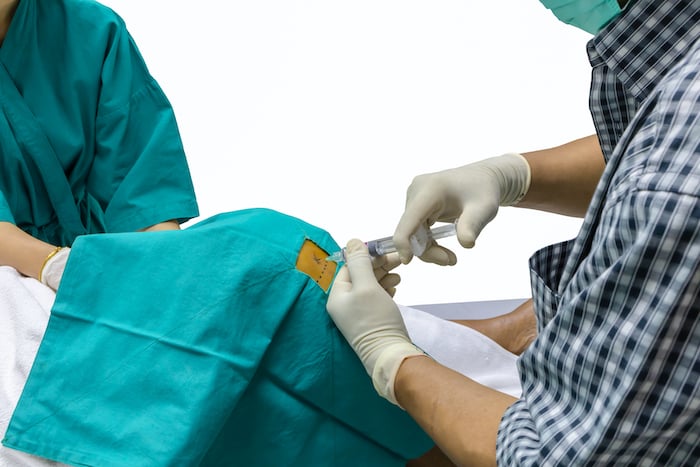Ou faire un infiltration radioguidée sur Paris ?
What is infiltration (injection)?
Joint infiltrations are non-surgical procedures that apply an anesthetic and corticosteroid solution directly to damaged joint tissue. This can give you the relief you need to improve your range of motion and participate in physiotherapy exercises that were too difficult for you before. Infiltrations are used to relieve pain, particularly in joints that are regularly used by the patient. For example, knee injection or the shoulder infiltration are cases that our experts frequently handle for patients who are top-level athletes.

How does infiltration work?
During infiltration, be sure to follow the doctor's and technician's recommendations.
Your cooperation is essential: it will help speed up the puncture procedure and reduce the risk of pain.
You lie flat on your stomach on an X-ray table.
After careful disinfection of the skin, the doctor administers a local anaesthetic, progressively deeper, to the area to be treated. This will reduce the sensitivity of the skin and muscles, making the infiltration as comfortable as possible for you.
Under fluoroscopic control (television), a needle is inserted close to the nerve.
A small amount of iodinated contrast medium is injected to check the correct position of the needle tip, then the drug is injected.
A few X-ray images are taken during the various phases of the examination. The whole procedure lasts around ten minutes, with the injection itself taking around a minute.
The day of the infiltration
With the exception of medications you have been specifically asked to stop, you will take your other treatments as usual.
Come preferably accompanied. You must not be sober.
For greater comfort, it is advisable to go to the toilet before the puncture.
Your doctor has suggested a radiological procedure. It will be performed with your consent.
You are free to accept or refuse.
You will be given information about the procedure and its aftermath.
The radiologist is qualified to judge the usefulness of this procedure in answering your doctor's diagnostic question. However, this procedure may not provide all the answers.
It's very important that you answer all the questions you may be asked about your state of health and the medication you are taking (written list of medications).
Certain treatments must be modified or discontinued for certain imaging tests.
Don't forget to bring along your previous exams for comparison, and above all to respect the recommendations made to you.
Why infiltration in a radiology department?
The procedure will be carried out using radioguidance (under televised control). This technique makes it possible to choose the right entry point for the needle and to follow its path as precisely as possible throughout the procedure.
Foraminal injection is performed on an outpatient basis, so does not require hospitalization.
Complications of infiltration
Any intervention on the human body, even when carried out with the utmost skill and safety, carries a risk of complication.
As with any puncture, there is a very small risk of infection.
Every precaution is taken to avoid this.
After your return home
Rest is recommended to ensure that the infiltration is more effective, and the effect will only become apparent after a few days.
In case of fever or severe pain in the days following infiltration (possible signs of infection),
it is important to contact your doctor or our team immediately on 01 79 36 1000. Contact your GP within 10 to 15 days to assess the effectiveness of this infiltration procedure.
The limits of injection
This injection may reduce your pain, but the result is not constant.
It may be necessary to repeat the gesture to obtain a complete result.
RDV INFILTRATION en ligne
Make an appointment for a mammogram at one of our centers:
Infiltrations Paris Bachaumont 75002
Clinique du Sport – Drouot 75009
Blomet radiology 75015
